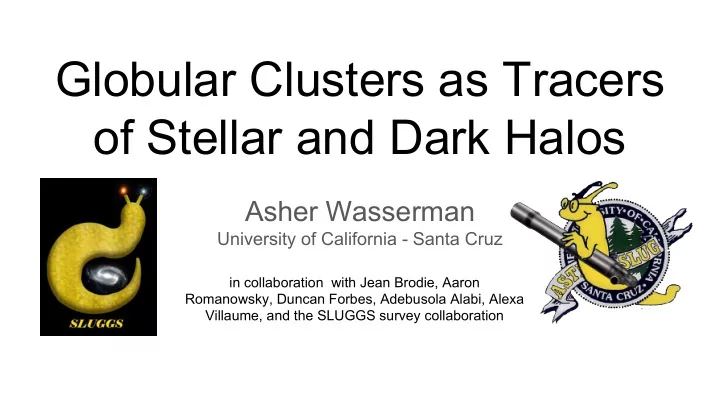

Globular Clusters as Tracers of Stellar and Dark Halos Asher Wasserman University of California - Santa Cruz in collaboration with Jean Brodie, Aaron Romanowsky, Duncan Forbes, Adebusola Alabi, Alexa Villaume, and the SLUGGS survey collaboration
Why study extragalactic globular clusters (GCs)? If we want to spectroscopically study galactic outskirts much beyond ~ 2 R e , we should look beyond the extent of the stellar light. Asher Wasserman -- Stellar Halos Across the Cosmos -- 5 July 2018
Why study extragalactic globular clusters (GCs)? If we want to spectroscopically study galactic outskirts much beyond ~ 2 R e , we should look beyond the extent of the stellar light. ~50 kpc Asher Wasserman -- Stellar Halos Across the Cosmos -- 5 July 2018
Observability: ● GCs are bright and ~50 kpc compact ● Can get radial velocities of GCs out to ≲ 30 Mpc in ~2 hours on 10 m telescope
Sizes of GC systems R e,GC ~ 2 R e,* Data from Forbes 2017d Asher Wasserman -- Stellar Halos Across the Cosmos -- 5 July 2018
GCs as dynamical tracers of dark matter (DM) GCs probe where DM dominates the potential. “Typical” mass model: log M * = 11, log M h = 13 Asher Wasserman -- Stellar Halos Across the Cosmos -- 5 July 2018
GCs as tracers of accretion GCs, particularly the blue subpopulation, may be good tracers of the accretion history of galaxies Wasserman+2018 (submitted) Rodriguez-Gomez+2016 Surface density In-situ Volume density 2 r half Ex-situ 10 kpc 100 kpc R r / r half Asher Wasserman -- Stellar Halos Across the Cosmos -- 5 July 2018
SLUGGS Survey SAGES Legacy Unifying Galaxies and GlobularS -- Brodie+2014 ● Representative sample of 25 elliptical/lenticular galaxies out to ~30 Mpc ● Keck/DEIMOS spectroscopy of GCs and integrated starlight ○ Use Calcium Triplet absorption lines at 8498, 8542 and 8662 Å ○ 1.5 Å resolution (σ ~23 km/s) ● Publicly released GC radial velocities ○ Forbes+2017d ○ http://sluggs.swin.edu.au ● Stellar kinematics ○ Foster+2016 Asher Wasserman -- Stellar Halos Across the Cosmos -- 5 July 2018
SLUGGS Survey DEIMOS as a wide-field IFU Asher Wasserman -- Stellar Halos Across the Cosmos -- 5 July 2018
SLUGGS Survey: GC and stellar kinematics GC kinematics from Forbes+2017b Stellar kinematics from Foster+2016 Asher Wasserman -- Stellar Halos Across the Cosmos -- 5 July 2018
SLUGGS Survey: DM fractions Alabi+2017 Tracer Mass Estimators Lovell+2018, submitted (note: != arXiv:1801.10170) M DM / M tot within outermost kinematic tracer Comparison with IllustrisTNG, aperture definition matters! Asher Wasserman -- Stellar Halos Across the Cosmos -- 5 July 2018
SLUGGS Survey: DM fractions Alabi+2017 Tracer Mass Estimators Lovell+2018, submitted (note: != arXiv:1801.10170) M DM / M tot within outermost kinematic tracer Comparison with IllustrisTNG, aperture definition matters! Asher Wasserman -- Stellar Halos Across the Cosmos -- 5 July 2018
SLUGGS Survey: GC-DM connection ● Forbes+2016 ● DM halo mass closely follows the blue (accreted) GC population mass. ● See also El-Badry+2018 Forbes+2016, with updates from Busola Alabi Asher Wasserman -- Stellar Halos Across the Cosmos -- 5 July 2018
SLUGGS Survey: Multi-population Jeans Modeling Wasserman+2018 (submitted, arXiv:1712.01229) See also Napolitano+2014 , Pota+2015, Zhu+2016, Oldham & Auger 2016 Mitigating the mass-anisotropy degeneracy: Three tracers in the same potential with different orbital anisotropy and spatial density. β = 1 - σ 2 tan / σ 2 rad Asher Wasserman -- Stellar Halos Across the Cosmos -- 5 July 2018
NGC 1407: DM density slope γ = -d(log ρ) / d(log r) as r -> 0 γ ~ 1 = NFW c 200 γ log M 200 Asher Wasserman -- Stellar Halos Across the Cosmos -- 5 July 2018
NGC 1407: Halo anisotropy ● Expectation of radial bias (β > 0) ● Evidence for a diversity of stellar halo anisotropy? ● β red ~ 0.4 (radially-biased orbits) ● β blue ≲ -4 (tangentially-biased orbits) Asher Wasserman -- Stellar Halos Across the Cosmos -- 5 July 2018
NGC 1407: Halo anisotropy Expectation of radial bias. Evidence for a diversity of orbital anisotropy? Amorisco 2018a radial tangential tangential radial NGC 1407 from Wasserman+2018 (submitted) NGC 5846 from Zhu+2014 M87 from Li & Zhu (in prep), see Ling Zhu’s slides! log M sat / M host Asher Wasserman -- Stellar Halos Across the Cosmos -- 5 July 2018
Future work ● SLUGGS GC probabilistic photometric catalogs ○ Better contamination modeling, assigning probabilities to point sources based on color, magnitude, and galactocentric distance ● Orbital Anisotropy of SLUGGS galaxies Hierarchical dynamical modeling of massive slow-rotators ● ○ Using Jeans models which can inform and be informed by galaxy/halo scaling relations Asher Wasserman -- Stellar Halos Across the Cosmos -- 5 July 2018
Summary 1. GCs offer the opportunity to study stellar & dark matter halos of galaxies beyond the Local Group on spatial scales which are difficult to probe in integrated stellar light. 2. Modeling multiple tracer populations (metal-rich GCs, metal-poor GCs, field stars) help mitigate the mass-anisotropy degeneracy. 3. There is evidence for a mysterious diversity of halo orbital anisotropy. Asher Wasserman -- Stellar Halos Across the Cosmos -- 5 July 2018
Recommend
More recommend